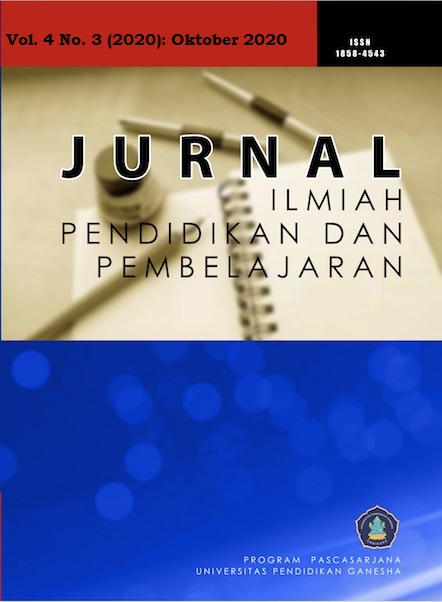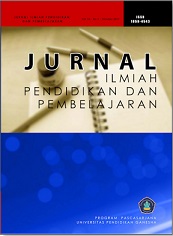Analisis Faktor Pembentuk Minat Kewirausahaan pada Jurusan Teknik Kendaraan Ringan SMK
DOI:
https://doi.org/10.23887/jipp.v4i3.28679Keywords:
Analisis Faktor Pembentuk, Minat KewirausahaanAbstract
Penelitian ini bertujuan untuk menganalisis faktor-faktor pembentuk minat kewirausahaan siswa berdasarkan faktor internal yaitu pendidikan, kepribadian, motivasi, peluang, komitmen, dan kepemimpinan. Jenis penelitian ini adalah deskriptif kuantitatif. Populasi dalam penelitian ini berjumlah 119 orang dan diambil 92 orang untuk dijadikan sampel dengan menggunakan rumus Slovin dengan presisi sebesar 5%. Teknik analisis data adalah analisis deskriptif dan analisis faktor konfirmatori untuk pengujian hipotesis. Hasil analisis Total Variance Esplained menyatakan bahwa ada 2 faktor yang terbentuk, kelompok faktor dengan eigenvalues faktor yang terbentuk 2,933 dan 1,257 maka diketahui variansi faktor 1 adalah 48,89% dan varian faktor 2 adalah 20,943%. Setelah dilaksanakan Rotation Sums of Squared Loadings faktor didapatkan perubahan nilai menjadi variansi faktor 1 adalah 48,098% dan varian faktor 2 adalah 22,735%. Dengan demikian faktor 1 yang terbentuk tersebut mampu menjelaskan 48,098% dan faktor 2 menjelaskan 22,735% dari variabelitas keenam variabel asli. Dari hasil penelitian dapat disimpulkan bahwa empat variabel yaitu pendidikan, kepribadian, motivasi, dan peluang yang menjadi faktor utama terbentuknya minat. Serta dua variabel komitmen, kepemimpinan yang lainnya menjadi faktor pendukung terbentuknya minat kewirausahaan siswa.
References
Adhitama. (2010). Faktor-Faktor Yang Mempengaruhi Minat Berwirausaha Studi Kasus Mahasiswa Fakultas Ekonomika Dan Bisnis Undip. Universitasb Dipenogoro.
Alma. (2013). Kewirausahaan untuk Mahasiswa dan Umum (Edisi Revi). Alfabeta.
Depdikbud. (2004). Garis-Garis Besar Program Pengajaran. Pusat Kurikulum Balitbang.
Dzulfikri, A., & Kusworo, B. (2019). Sikap, Motivasi, dan Minat Berwirausaha Mahasiswa di Surabaya. JKMP (Jurnal Kebijakan Dan Manajemen Publik), 5(2), 183. https://doi.org/10.21070/jkmp.v5i2.1310
Fauziah, A., Rosnaningsih, A., & Azhar, S. (2017). Hubungan Antara Motivasi Belajar Dengan Minat Belajar Siswa Kelas Iv Sdn Poris Gaga 05 Kota Tangerang. Jurnal JPSD (Jurnal Pendidikan Sekolah Dasar), 4(1), 47. https://doi.org/10.26555/jpsd.v4i1.a9594
Ganefri, & Hidayat, H. (2013). Rahasia Kewirausahaan. Alfabeta.
Hanghon, P., & Rinthaisong, I. (2018). Confirmatory factor analysis of collaboration model in non-formal higher education management in southern Thailand. Kasetsart Journal of Social Sciences, 39(3), 472–477. https://doi.org/10.1016/j.kjss.2018.06.012
Hartini, K. (2019). Analisis Faktor- Faktor Yang Mempengaruhi Minat Mahasiswa ( Studi Kasus Mahasiswa Fakultas Ekonomi dan Bisnis Islam IAIN Bengkulu ) Kustin Hartini , SE , MM A . Pendahuluan Negara sebuah Negara berkembang dengan adalah Mengapa ? Padahal Negara kita dikena. AL-INTAJ, 5(1). https://doi.org/http://dx.doi.org/10.29300/aij.v5i1.1714
Hisrich. (2010). Entrepreneurship (7th Editio). Mcgraw-Hill.
Indrawati, N. K., Salim, U., Djumahir, & Djawahir, A. H. (2015). Moderation Effects of Entrepreneurial Self-efficacy in Relation between Environmental Dimensions and Entrepreneurial Alertness and the Effect on Entrepreneurial Commitment. Procedia - Social and Behavioral Sciences, 169(August 2014), 13–22. https://doi.org/10.1016/j.sbspro.2015.01.281
Indriyani, I., & Subowo. (2019). Pengaruh Pengetahuan Kewirausahaan dan Lingkungan Keluarga Terhadap Minat Berwirausaha Melalui Self-Efficacy. Economic Education Analysis Journal, 2(1), 18–23. https://doi.org/10.15294/eeaj.v8i2.31493
Iskandarini. (2014). The Impact of Entrepreneurial Barrier toward Entrepreneurial Intention for Decreasing Unemployment through Community Empowerment. Procedia - Social and Behavioral Sciences, 115(Iicies 2013), 166–174. https://doi.org/10.1016/j.sbspro.2014.02.425
Kurniawan, A., Khafid, M., & Pujiati, A. (2016). Pengaruh Lingkungan Keluarga, Motivasi, dan Kepribadian Terhadap Minat Wirausaha Melalui Self Efficacy. Journal of Economic Education, 5(1), 100–109.
Lindblom, A., Lindblom, T., & Wechtler, H. (2020). Retail entrepreneurs’ exit intentions: Influence and mediations of personality and job-related factors. Journal of Retailing and Consumer Services, 54(August 2019), 102055. https://doi.org/10.1016/j.jretconser.2020.102055
López-Núñez, M. I., Rubio-Valdehita, S., Aparicio-García, M. E., & Díaz-Ramiro, E. M. (2020). Are entrepreneurs born or made? The influence of personality. Personality and Individual Differences, 154(November). https://doi.org/10.1016/j.paid.2019.109699
Meredith, G, Geoffrey, Al, E. (2000). Kewirausahaan: Teori dan Praktek (Seri terje). Pustaka Binaman Pressindo.
Prilovia, H., & Iskandar, I. (2018). Minat Wirausaha Mahasiswa Fakultas Ekonomi Unswagati Cirebon. Edunomic Jurnal Pendidikan Ekonomi, 6(2), 57. https://doi.org/10.33603/ejpe.v6i2.1510
Putri, N. L. W. W. (2017). Pengaruh Pendidikan Kewirausahaan Terhadap Minat Mahasiswa Untuk Berwirausaha Pada Mahasiswa Pendidikan Ekonomi Universitas Pendidikan Ganesha. Jurnal Pendidikan Ekonomi Undiksha, 9(1), 137. https://doi.org/10.23887/jjpe.v9i1.19998
Rahmadi, A. N., & Heryanto, B. (2017). Analisis Faktor-Faktor Yang Mempengaruhi Minat Berwirausaha Pada Mahasiswa Program Studi Manajemen Fakultas Ekonomi Universitas Kadiri. Ekonika : Jurnal Ekonomi Universitas Kadiri, 1(2), 153–169. https://doi.org/10.30737/ekonika.v1i2.13
Ramlan, P., & Nikmat, R. (2019). Pendekatan Manajemen Strategik Dalam Melalui Program Kreativitas Mahasiswa-Kewirausahaan ( Pmk-K ). 5, 240–250.
Riduwan. (2006). Metode dan Teknik Penyusunan Tesis. Alfabeta.
Rismanandi, S., & Yoto. (2015). Analisis Faktor-Faktor Minat Berwirausaha. Jurnal Teknik Mesin, 23(2), 1–14. http://journal2.um.ac.id/index.php/jurnal-teknik-mesin/article/viewFile/507/320
Sarabi, A., Froese, F. J., Chng, D. H. M., & Meyer, K. E. (2020). Entrepreneurial leadership and MNE subsidiary performance: The moderating role of subsidiary context. International Business Review, 29(3), 101672. https://doi.org/10.1016/j.ibusrev.2020.101672
Sari, L. I. S. S. (2015). Penerapan Model Pembelajaran Berbasis Proyek ( Project Based Learning ) untuk Meningkatkan Hasil Belajar Keterampilan Berbicara Siswa Kelas VA SDN Ajung 03 ( The Application of Method Project Based Learning for Improving Learning Outcomes on Speaking Skil. Jurnal Edukasi UNEJ, 2(1), 11–14.
Sjukur, S. B. (2013). Pengaruh blended learning terhadap motivasi belajar dan hasil belajar siswa di tingkat SMK. Jurnal Pendidikan Vokasi, 2(3), 368–378. https://doi.org/10.21831/jpv.v2i3.1043
Suryaman. (2006). Minat Berwirausaha Pada Mahasiswa Pendidikan Teknik. Alfabeta.
Suryana. (2013). Kewirausahaan : Kiat dan Proses Menuju Sukses. Salemba Empat.
Tarmudji. (2006). Menajemen Bisnis. Liberti.
Virgianto, G., Permana, T., Komaro, M., & Indonesia, U. P. (2019). Minat Bekerja, Berwirausaha, Dan Melanjutkan Studi Siswa Jurusan Teknik Kendaraan Ringan. Minat Bekerja, Berwirausaha, Dan Melanjutkan Studi Siswa Jurusan Teknik Kendaraan Ringan, 6(1), 36–41. https://doi.org/10.17509/jmee.v6i1.18239
Wardana, L. W., Narmaditya, B. S., Wibowo, A., Mahendra, A. M., Wibowo, N. A., Harwida, G., & Rohman, A. N. (2020). The impact of entrepreneurship education and students’ entrepreneurial mindset: the mediating role of attitude and self-efficacy. Heliyon, 6(9), e04922. https://doi.org/10.1016/j.heliyon.2020.e04922
Wiwin Novitasyari, Tati, S., & Rahmawati, Y. (2017). Minat Berwirausaha Mahasiswa Program Studi Pendidikan Tata Boga Universitas Pendidikan Indonesia. Media Pendidikan, Gizi, Dan Kuliner, 6(2), 81–93. https://ejournal.upi.edu/index.php/Boga/article/download/9030/5624
Yulita, Muhamad, S., Kulub Abdul Rashid, N., Hussain, N. E., Mohamad Akhir, N. H., & Ahmat, N. (2020). Resilience as a moderator of government and family support in explaining entrepreneurial interest and readiness among single mothers. Journal of Business Venturing Insights, 13(June 2019), e00157. https://doi.org/10.1016/j.jbvi.2020.e00157
Downloads
Published
How to Cite
Issue
Section
License
Authors who publish with the Jurnal Ilmiah Pendidikan dan Pembelajaran (JIPP) agree to the following terms:
- Authors retain copyright and grant the journal the right of first publication with the work simultaneously licensed under a Creative Commons Attribution License (CC BY-SA 4.0) that allows others to share the work with an acknowledgment of the work's authorship and initial publication in this journal.
- Authors are able to enter into separate, additional contractual arrangements for the non-exclusive distribution of the journal's published version of the work (e.g., post it to an institutional repository or publish it in a book), with an acknowledgment of its initial publication in this journal.
- Authors are permitted and encouraged to post their work online (e.g., in institutional repositories or on their website) prior to and during the submission process, as it can lead to productive exchanges, as well as earlier and greater citation of published work. (See The Effect of Open Access)










